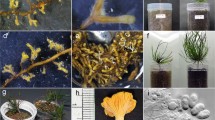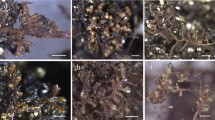Abstract
The cultivation of the black truffle, Tuber melanosporum (Vitt.), is based upon plantation of seedlings artificially infected with Tuber. At the present time, neither the host-plant nor the fungal material used for planting truffle orchards are genetically well defined. Cloning the host-plant was performed as a first step in improvement. A clone of hazel (Corylus avellana L.) was artificially infected with T. melanosporum. The heterogeneity of the root volume was not completely suppressed by cloning but very extensive growth unfavorable to Tuber colonization rarely occurred. The root system was highly receptive to ectomycorrhizal fungi. The percentage of roots infected by T. melanosporum reached a higher level on cloned hazels than uncloned seedlings. The relation between Tuber and other symbionts appeared to depend on the morphology of the root system. T. melanosporum spread more easily on medium-sized root systems whereas the other symbionts (Scleroderma sp., Cenococcum sp., Pulvinula globifera) developed in parallel to the root volume. The practical potential of this system is discussed.
Similar content being viewed by others
Author information
Authors and Affiliations
Additional information
Accepted: 4 June 1995
Rights and permissions
About this article
Cite this article
Mamoun, M., Olivier, JM. Receptivity of cloned hazels to artificial ectomycorrhizal infection by Tuber melanosporum and symbiotic competitors. Mycorrhiza 6, 15–19 (1995). https://doi.org/10.1007/s005720050100
Issue Date:
DOI: https://doi.org/10.1007/s005720050100




